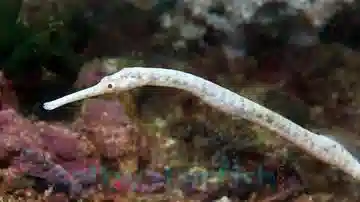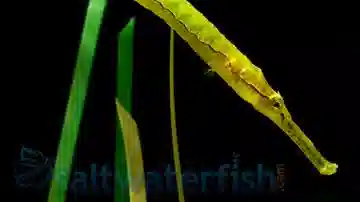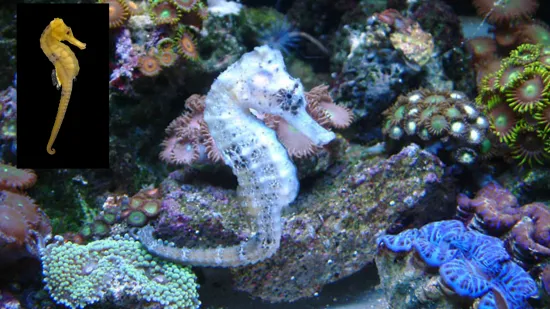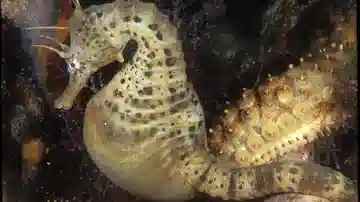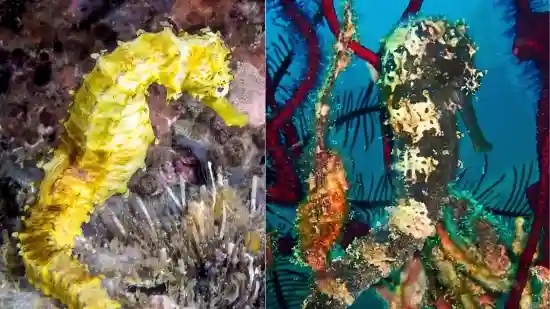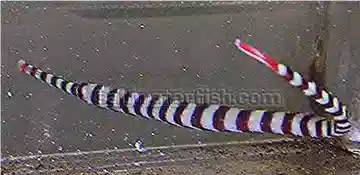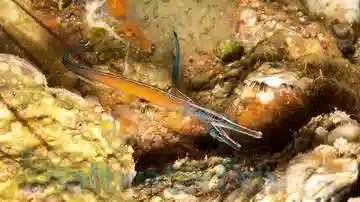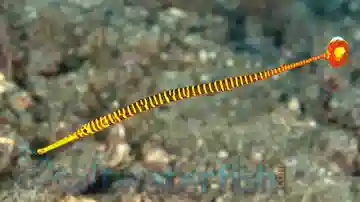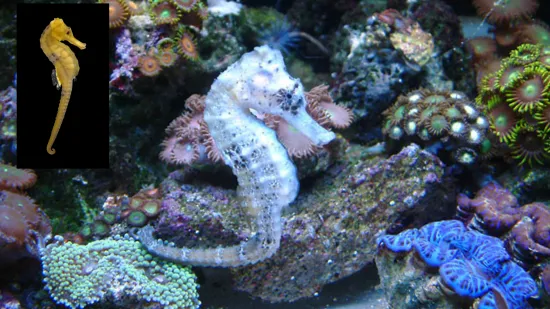Seahorses In Saltwater Aquariums: FAQ
Yes and you absolutely should. Captive-bred seahorses are widely available from reputable online retailers like Saltwaterfish.com, and they are by far the best choice for nearly every home aquarium. Unlike wild-caught seahorses, which often suffer from stress, parasites, and difficulty adapting to frozen food, captive-bred seahorses are healthier, hardier, and more sustainable.
Why choose captive-bred seahorses:
Hardier and disease-resistant: Raised entirely in aquariums, captive-bred seahorses are already adapted to enclosed systems and human care. They handle water changes, temperature shifts, and feeding routines far better than their wild counterparts.
Readily eat frozen foods: Most captive-bred species—like the Lined Seahorse (Hippocampus erectus)—readily accept frozen mysis shrimp, making daily feeding easy and consistent.
Eco-friendly and sustainable: Purchasing captive-bred stock helps protect vulnerable wild populations that are still recovering from overcollection and habitat loss.
Ethically responsible: Captive breeding supports conservation-driven aquaculture instead of removing animals from fragile seagrass beds and coral reefs.
Longer lifespan: With stable care, captive-bred seahorses can live 3–5 years or longer, compared to much shorter survival rates for wild-caught specimens.
Koldewey & Martin-Smith (2010) reviewed global breeding programs and found that captive-bred seahorses show higher feeding efficiency, reduced stress, and significantly better survival than wild-caught individuals.
One Saltwaterfish.com reviewer of the Erectus Seahorse \- Captive Bred shared: “Really impressed with he durability of this little guy- we’ve had power outages that caused crazy temperatures, raging algae outbreaks, etc and he’s still kicking\! Really worth the cost of shipping instead of getting one of questionable origins from my local fish store.”
Pro tips for success:
Keep tank temperature around 72–75°F to reduce bacterial risk.
Feed frozen mysis 2–3 times daily, enriched with vitamins or HUFA supplements.
Use gentle filtration and calm water flow to accommodate their unique swimming style.
Bottom line:
Yes, you can and should buy captive-bred seahorses online. They are healthier, easier to care for, and help preserve wild populations. When you choose captive-bred from Saltwaterfish.com, you’re not just adding a fascinating species to your tank, you’re supporting responsible marine aquaculture. All seahorses are backed by our 8-Day Live Guarantee, so you can order with total confidence.
Seahorses may look delicate, but they need plenty of space and pristine water to thrive. The right tank size is one of the most important factors in their long-term success. While they aren’t fast swimmers, seahorses rely on stable water conditions, low stress, and vertical swimming space—so bigger is almost always better.
Minimum tank size recommendations:
Pairs of standard-sized seahorses (e.g., Lined Seahorse, Hippocampus erectus): At least 30 gallons for one pair, with an additional 15 gallons for each extra pair.
*Dwarf seahorses (Hippocampus zosterae): Can live comfortably in 5–10 gallons, but require careful feeding of live foods.
*Large species (e.g., H. reidi, H. abdominalis): Need 50 gallons or more due to their size and oxygen demands.
Why tank size matters:
Water stability: Larger volumes dilute waste and make it easier to maintain stable temperature, salinity, and pH.
Vertical space: Seahorses court and breed by rising upward together—tanks at least 18–20 inches tall are essential for natural behavior.
Stress reduction: More room means less competition for hitching spots and food, leading to stronger, healthier fish.
Filtration and flow: A larger tank allows for gentle circulation that keeps oxygen high without buffeting the seahorses.
One Saltwaterfish.com reviewer of the Erectus Seahorse \- Captive Bred shared: “Excellent quality, they began eating as soon as they were received and acclimated, still doing very nicely. I am very happy with them and they seem to be very happy here with me.”
Pro setup tips:
Maintain temperatures around 72–75°F to reduce bacterial risk.
Use gentle filtration with minimal current.
Provide plenty of hitching posts, such as macroalgae or artificial coral branches.
- Avoid aggressive or fast-moving tankmates that can outcompete seahorses for food.
Bottom line:
For most home aquariums, plan on at least 30 gallons per pair of standard-sized seahorses, with taller tanks preferred. Stable conditions and space for vertical movement are critical to their health, breeding success, and longevity. For healthy, captive-bred seahorses ideal for home systems, explore Saltwaterfish.com’s selection—all backed by our 8-Day Live Guarantee for confident, sustainable reefkeeping.
Adding seahorses to a saltwater aquarium is rewarding, but these unique fish have specialized needs that differ from most reef inhabitants. Before introducing them, it’s important to plan for tank design, flow rate, diet, and tankmate compatibility. With the right preparation, seahorses can thrive for years and even breed successfully in home systems.
Choose captive-bred seahorses.
Always start with captive-bred species such as the Lined Seahorse (Hippocampus erectus) or H. reidi. Captive-bred seahorses are hardier, disease-free, and already trained to eat frozen foods, making them far easier to care for than wild-caught specimens.
Pick the right tank setup.
Minimum size: 30 gallons per pair, with tanks at least 18 inches tall for natural courtship and swimming.
Gentle water flow—too much current can exhaust them.
Temperature range: 72–75°F to prevent bacterial infections.
Stable salinity (1.022–1.025) and excellent filtration for water quality.
Include hitching posts (macroalgae, gorgonians, or fake coral branches) for resting and feeding.
Feed a specialized diet.
Offer frozen mysis shrimp 2–3 times daily, ideally enriched with vitamins or HUFA supplements. Many aquarists target-feed using turkey basters to ensure each seahorse eats adequately.
Choose tankmates carefully.
Avoid fast, aggressive fish that outcompete them for food (like wrasses or tangs). Peaceful options include pipefish, gobies, and small snails or cleaner shrimp.
One Saltwaterfish.com reviewer of the Erectus Seahorse \- Captive Bred shared: “I ordered two of these seahorses... They are fat and very healthy\!\! Great shipping too\! As soon as I acclimated them and put them in the tank they were eating frozen mysis shrimp... Loved them so much I just ordered two more..:) Thanks so much saltwater fish.com ... I have ordered a lot from you guys and have never been disappointed\!”
Pro tips for first-time seahorse keepers:
Keep tanks free from stinging corals and anemones.
Perform small, regular water changes to maintain pristine water.
Use gentle lighting and avoid sudden movements near the tank.
Bottom line:
Before adding seahorses, ensure your aquarium is tall, stable, and peaceful, with low flow and easy access to frozen mysis shrimp. Starting with captive-bred seahorses greatly increases success and supports sustainable aquaculture. Browse Saltwaterfish.com’s collection of captive-bred seahorses—each backed by our 8-Day Live Guarantee—for healthy, well-conditioned specimens ready to thrive in your home aquarium.
Seahorses have small stomachs and no true digestive tract, which means food passes through them quickly. To stay healthy, active, and well-nourished, they need frequent, small feedings throughout the day. Feeding consistency is one of the most important factors in keeping seahorses thriving long-term in a home aquarium.
General feeding frequency:
Feed 2–3 times daily for adult seahorses. Woods (2003) showed that juvenile Hippocampus abdominalis fed multiple small meals grew faster and had higher survival than those fed once daily.
Juvenile seahorses or newly introduced individuals may benefit from 3–4 smaller meals until they adjust.
Try to feed at the same times each day—seahorses quickly learn your routine and will gather at feeding spots.
What to feed:
Primary diet: Frozen mysis shrimp, enriched with vitamins or HUFA supplements (like Selcon or Vita-Chem).
Occasional variety: Enriched brine shrimp, copepods, or small amphipods to stimulate natural hunting behavior.
Avoid flakes or pellets—seahorses require moving foods they can easily spot and snick up with their tubular snouts.
Feeding techniques for success:
Target-feed with a turkey baster or feeding station to ensure each seahorse gets enough food.
Turn off or reduce water flow briefly during feeding to keep mysis shrimp from drifting away.
Remove uneaten food after 10–15 minutes to maintain water quality.
Pro feeding tips:
Keep a consistent feeding schedule to reduce stress and encourage natural feeding behavior.
Vary food types for nutritional balance.
Observe each seahorse to confirm both individuals are eating; dominant ones may eat faster.
Bottom line:
Feed your seahorses two to three small meals a day using high-quality frozen mysis shrimp and gentle feeding techniques. Frequent, steady feeding mimics their natural grazing behavior and keeps them healthy, colorful, and active. For healthy, captive-bred seahorses that arrive already trained to eat frozen foods, explore Saltwaterfish.com’s seahorse collection—all backed by our 8-Day Live Guarantee for confidence from day one.
Most captive-bred seahorses do not require live food, they readily eat frozen mysis shrimp and other prepared foods. In fact, this is one of the biggest advantages of choosing captive-bred seahorses over wild-caught ones. While wild seahorses often refuse anything that isn’t alive, captive-bred individuals are raised in aquariums and trained from a young age to recognize frozen mysis as their primary food source.
Captive-bred seahorses:
Easily accept frozen mysis shrimp (their main diet in captivity).
Thrive on 2–3 small feedings per day of thawed, enriched frozen food.
Benefit from occasional live treats (like enriched brine shrimp or copepods) for variety and stimulation—but it’s not required for survival.
Wild-caught seahorses:
Typically eat only live prey such as amphipods, copepods, and small shrimp.
Can be difficult or impossible to transition to frozen foods.
Often arrive stressed or malnourished, making them unsuitable for most home aquariums.
Best frozen foods for seahorses:
PE Mysis, Hikari, or San Francisco Bay Brand frozen mysis shrimp.
Enrich with supplements like Selcon or Vita-Chem to boost nutrition.
- Feed gently with a turkey baster or feeding station to control portions and reduce waste.
Pro feeding tip:
Offer small, frequent portions. Seahorses lack true stomachs, so they must eat multiple times a day. Supplement frozen feedings with the occasional live snack to keep them active and engaged.
Bottom line:
Healthy, captive-bred seahorses do not need live food—they thrive on a diet of high-quality frozen mysis shrimp, enriched and offered in small, regular feedings. Live foods can be used for enrichment but aren’t necessary for success. To ensure easy feeding and long-term health, choose captive-bred seahorses from Saltwaterfish.com—each backed by our 8-Day Live Guarantee for safe, confident acclimation and feeding success.
Creating a seahorse-friendly environment means designing your aquarium around their unique needs: calm water flow, vertical space, stable conditions, and gentle tankmates. Seahorses are not typical reef fish; they rely on specialized setups that prioritize stability and safety over strong currents or bright lights. With proper planning, your aquarium can provide the perfect environment for these fascinating and graceful creatures.
Choose the right tank size and shape.
Minimum 30 gallons for a pair of standard-sized seahorses like the Lined Seahorse (Hippocampus erectus).
Tall tanks (18+ inches) are essential for natural courtship and swimming behavior.
Larger tanks (40–50+ gallons) make it easier to maintain stable water quality.
Maintain ideal water conditions.
Temperature: 72–75°F (cooler than most reef setups).
Salinity: 1.022–1.025 specific gravity.
pH: 8.1–8.4, with low nitrate levels.
Gentle filtration and oxygenation without strong flow that could tire them out.
Create a calm, structured aquascape.
Use live rock for biological filtration and natural grazing surfaces.
Add hitching posts—macroalgae, gorgonians, or artificial coral branches—so seahorses can rest and feed comfortably.
Keep lighting moderate; strong reef lights can stress them.
Wong & Benzie (2003) “The effects of tank volume and stocking density on juvenile seahorse (Hippocampus whitei) growth and survival” found that seahorses in larger, low-turbulence tanks had higher survival and reduced stress
Pick peaceful tankmates.
Avoid fast or aggressive fish like tangs, wrasses, and clownfish. Instead, pair seahorses with gentle species such as pipefish, gobies, or cleaner shrimp.
Pro setup tips:
Use sponge filters or adjustable flow pumps to maintain circulation without turbulence.
Keep a dedicated thermometer and heater controller for precise temperature control.
Add peaceful clean-up crew members—snails, micro hermits, or peppermint shrimp—for maintenance.
Bottom line:
A seahorse-friendly aquarium should be tall, stable, and tranquil, with moderate lighting, low flow, and plenty of hitching structures. Choose captive-bred seahorses for the best results, they adapt beautifully to these conditions and readily accept frozen foods. For healthy, sustainably bred seahorses that arrive ready to thrive, explore Saltwaterfish.com’s collection, all backed by our 8-Day Live Guarantee for worry-free success.
Yes, you can absolutely keep multiple seahorses together and in fact, they often do best in small groups or pairs. Seahorses are peaceful, social fish that display natural bonding and even courtship behaviors when housed together. However, to ensure harmony and health, you’ll need to provide adequate space, stable conditions, and consistent feeding routines.
Best practices for keeping multiple seahorses:
Tank size: Allow at least 30 gallons for the first pair, plus 15 gallons for each additional pair. More water volume improves stability and gives each seahorse enough territory.
Species consistency: Keep seahorses of the same species and size (e.g., all Lined Seahorses (Hippocampus erectus)). Mixing species can lead to feeding or temperature incompatibilities.
Calm water flow: Multiple seahorses need gentle circulation to avoid stress and competition during feeding.
Plenty of hitching spots: Provide gorgonians, macroalgae, and branching corals so each seahorse can perch comfortably without crowding.
Feeding consistency: Offer frozen mysis shrimp 2–3 times daily. Use a feeding station or target-feeding method to ensure all individuals eat equally.
Social behavior:
Seahorses are non-aggressive toward one another and often engage in fascinating displays such as tail-holding or synchronized swimming. Vincent & Sadler (1995) found that seahorses form faithful social bonds and thrive in paired environments.
Pro tips for group success:
Introduce seahorses at the same time to prevent territory issues.
Avoid mixing with aggressive or faster tankmates that compete for food.
Keep up with regular water changes—more animals means a higher bio-load.
Bottom line:
Yes, multiple seahorses can live together peacefully and even thrive as social groups provided the tank is spacious, stable, and tailored to their calm nature. Captive-bred species adapt especially well to group living and feeding routines. For healthy, compatible seahorses ready to pair or form small colonies, explore Saltwaterfish.com’s selection of captive-bred seahorses, all backed by our 8-Day Live Guarantee for confident, sustainable reefkeeping.
Yes, seahorses are reef safe, but not all reef environments are seahorse friendly. They won’t harm corals or invertebrates, but most standard reef tanks have strong water flow, aggressive fish, and intense lighting that make life difficult for these gentle swimmers. To safely keep seahorses in a reef setting, the tank must be tailored to their calm, low-energy lifestyle.
What makes seahorses reef safe:
Non-destructive behavior: Seahorses won’t nip, dig, or disturb corals. They perch on branches and rocks rather than hiding inside them.
Peaceful temperament: They won’t compete for territory or harass tankmates.
Compatibility with invertebrates: Seahorses coexist well with snails, cleaner shrimp, micro hermits, feather dusters, and other peaceful reef inhabitants.
What reef conditions can be unsafe:
Strong currents: High flow designed for SPS corals can exhaust seahorses. Gentle, indirect flow is essential.
Aggressive or fast fish: Avoid tangs, wrasses, clownfish, and damsels that outcompete them for food.
Stinging corals and anemones: Large LPS corals, bubble corals, and anemones can injure seahorses when they hitch too close.
Corals that work well in seahorse reefs:
Soft corals and leathers (Sinularia, Sarcophyton).
Gorgonians, macroalgae, and branching non-stinging corals.
Zoanthids and mushrooms, if flow and temperature remain moderate.
Pro tips for success in reef environments:
Maintain moderate light (LED or T5) rather than high-intensity reef lighting.
Use gentle, variable flow pumps or deflectors to reduce direct current.
Feed frozen mysis shrimp 2–3 times daily and target-feed to ensure proper nutrition.
- Keep temperature at 72–75°F, slightly cooler than typical reef tanks.
Bottom line:
Seahorses are reef safe but require calm, low-flow reef environments to thrive. They coexist beautifully with soft corals, macroalgae, and peaceful invertebrates—but not in high-energy SPS systems. Choose captive-bred seahorses, which adapt best to aquarium life, and build a reef designed around their slower, graceful lifestyle. Find healthy, sustainably bred seahorses at Saltwaterfish.com, all backed by our 8-Day Live Guarantee for confident reefkeeping.
Keeping seahorses with other saltwater fish can be rewarding, but it’s not as simple as adding them to a typical community tank. Seahorses are gentle, slow-moving animals that require calm tankmates, controlled flow, and specialized feeding routines. When housed with the wrong companions, they can become stressed, outcompeted for food, or even injured. The key is understanding their unique needs and carefully choosing compatible species.
Main challenges when mixing seahorses with other fish:
Feeding competition: Seahorses eat slowly, picking individual pieces of food from the water column. Fast eaters like wrasses, tangs, or clownfish will quickly consume mysis shrimp before seahorses get a chance.
Strong water flow: Many reef tanks use high circulation to support SPS corals, but this can physically exhaust seahorses and make feeding nearly impossible.
Aggression and nipping: Even mildly territorial fish can harass seahorses or nip their fins and tails. Stress from this behavior can weaken their immune systems.
Disease transmission: Seahorses are vulnerable to pathogens carried by wild-caught or aggressive fish species. Quarantine and selecting captive-bred companions are essential.
Temperature differences: Seahorses prefer cooler water (72–75°F), which may not suit tropical fish that require 78–80°F.
Compatible tankmates for seahorses:
Peaceful species like pipefish, small gobies, firefish, or scooter blennies.
Non-aggressive invertebrates such as snails, feather dusters, and cleaner shrimp.
Avoid all aggressive, fast-swimming, or nippy species.
Job et al. (2002) found that Hippocampus kuda kept in calm, low-competition environments exhibited higher feeding efficiency and reduced stress compared to those exposed to faster tankmates
Pro tips for mixed systems:
Use feeding stations or target-feed seahorses separately to ensure they eat enough.
Keep flow gentle with spray bars or adjustable wavemakers.
Quarantine all new fish before introduction to prevent disease.
- Monitor interactions daily during the first week.
Bottom line:
The main challenges of keeping seahorses with other saltwater fish are feeding competition, water flow, and aggression. However, with a calm environment, careful tankmate selection, and captive-bred species, it’s possible to create a peaceful, balanced setup where seahorses and compatible fish thrive together. For healthy, captive-bred seahorses ready for community systems, visit Saltwaterfish.com’s collection—all backed by our 8-Day Live Guarantee for confident, sustainable aquarium keeping.
Seahorses are delicate, slow-moving fish that require gentle, gradual acclimation to avoid stress and shock from new water conditions. Because they’re highly sensitive to temperature, salinity, and pH changes, a slow and steady approach ensures your seahorses adjust comfortably and start feeding confidently within hours.
Step-by-step guide to acclimating seahorses:
Float the bag (15–20 minutes):
Keep the sealed shipping bag in your tank to equalize temperature. Avoid sudden light exposure or rough handling.
Transfer to a clean container:
Pour the seahorse and bag water into a small, sanitized bucket or specimen container—never directly into your aquarium.
Drip acclimation (45–60 minutes):
Use airline tubing to drip your tank water into the container at 2–4 drops per second. Continue until the water volume has doubled. This slow process helps match temperature, pH, and salinity levels safely.
Remove the seahorses gently:
Use a soft net or your hand to transfer them into the aquarium. Avoid adding shipping water to your display tank.
Lights off for several hours:
Dim or turn off aquarium lights for the first 6–8 hours to reduce stress during introduction.
Observe closely:
Watch for signs of stress such as rapid breathing or floating. Healthy seahorses should perch on hitching spots and move calmly within a few hours.
Acclimation best practices:
Quarantine new arrivals for 2–3 weeks if possible to prevent introducing pathogens.
Maintain temperature between 72–75°F and salinity between 1.022–1.025. Lin et al. (2009) demonstrated that Hippocampus erectus exposed to stable salinity and temperature had higher survival and feeding rates
Begin offering frozen mysis shrimp within the first 24 hours to encourage feeding behavior.
Pro tips for success:
Use a bucket or container with rounded edges to prevent tail injuries.
Keep your environment quiet during acclimation, avoid loud noises or sudden movement.
If your home has strong lighting, drape a towel loosely over the acclimation container to prevent stress.
Bottom line:
Proper acclimation is crucial to seahorse survival. Take at least 45–60 minutes for temperature and salinity adjustment, transfer gently, and keep lighting low for a smooth transition. With this approach—and by starting with captive-bred seahorses—you’ll set them up for immediate success. Order from Saltwaterfish.com to receive healthy, captive-bred seahorses backed by our 8-Day Live Guarantee, ensuring confident, stress-free acclimation from day one.
Seahorses are gentle, slow-moving fish that thrive best with peaceful, low-energy tankmates. Because they feed slowly and rely on calm water flow, they can’t compete with fast or aggressive species. Choosing compatible companions helps maintain a balanced, stress-free environment where seahorses can eat, explore, and display natural behavior.
Safe tank mates for seahorses:
Pipefish: Closely related to seahorses, they share similar diets and temperaments.
Small gobies: Species like the Neon Goby (Elacatinus oceanops) and Watchman Goby (Cryptocentrus cinctus) make excellent companions.
Firefish: Peaceful, elegant swimmers that occupy different areas of the tank.
Scooter blennies: Slow, bottom-dwelling fish that rarely disturb seahorses.
Mandarinfish (Synchiropus splendidus): Compatible in mature tanks with established copepod populations.
Cleaner shrimp and peppermint shrimp: Non-aggressive and beneficial for tank health.
Snails and micro hermit crabs: Gentle clean-up crew that helps control algae and detritus.
Tankmates to avoid:
Aggressive or fast feeders like clownfish, tangs, wrasses, and damsels.
Predatory species such as triggers or puffers that may harass or nip tails.
Stinging invertebrates including anemones, large LPS corals, and hydroids, which can injure seahorses when they hitch too close.
Why compatibility matters:
Seahorses rely on slow, deliberate feeding—usually targeting frozen mysis shrimp several times a day. Fast, competitive fish often outcompete them for food, leading to malnutrition and stress. Selecting compatible species ensures each animal thrives without conflict.
Pro compatibility tips:
Introduce seahorses before or at the same time as tankmates to prevent territorial issues.
Maintain gentle flow using adjustable pumps or spray bars.
Feed seahorses with target feeding to ensure they get adequate nutrition.
Keep temperature slightly cooler (72–75°F) to match seahorse needs.
Bottom line:
Safe tankmates for seahorses are peaceful, slow-moving species like gobies, firefish, pipefish, mandarins, and small shrimp. Avoid aggressive or high-flow community fish to keep your tank calm and balanced. For captive-bred seahorses that thrive in these peaceful setups, visit Saltwaterfish.com—each backed by our 8-Day Live Guarantee for healthy arrivals and confident pairing.
Yes, male seahorses are one of nature’s most extraordinary exceptions. Unlike almost every other animal species, it’s the male seahorse that carries and gives birth to the young. This unique reproductive behavior is one of the defining traits of the Hippocampus genus and a major reason seahorses continue to fascinate both scientists and aquarists.
How male seahorse pregnancy works:
Courtship and pairing: During mating, a male and female seahorse perform an elegant “dance,” often wrapping tails and swimming side by side. Once bonded, the female transfers her eggs into a specialized brood pouch located on the male’s abdomen.
Internal fertilization: The male fertilizes the eggs inside the pouch, where they embed in the pouch tissue—similar to a mammalian placenta.
Gestation period: Over 2–4 weeks, the male provides oxygen, nutrients, and protection to developing embryos while maintaining stable salinity and temperature levels inside the pouch.
Birth: When fully developed, the male goes into labor, expelling dozens to hundreds of tiny, fully formed baby seahorses (called fry) into the water column.
Why this adaptation evolved:
Male pregnancy allows females to produce more eggs while the male incubates, increasing reproductive success. It’s a remarkable example of role reversal and cooperative parenting in the marine world.
Fun fact: Whittington et al. (2015) found that the male Hippocampus abdominalis brood pouch expresses genes similar to those used in mammalian pregnancy, regulating oxygen and nutrient exchange for developing embryos
Pro care tips for breeding pairs:
Keep water stable and slightly cooler (72–75°F) to support pregnancy.
Offer nutrient-rich frozen mysis shrimp and vitamin supplements to strengthen both parents.
Remove fry or place the male in a breeder net before labor to improve survival rates.
Avoid strong flow—newborn fry are weak swimmers and easily displaced.
Bottom line:
Yes, male seahorses truly give birth, an extraordinary biological process that sets them apart from nearly every other fish. The male’s brood pouch protects and nourishes the developing young until they’re ready for life on their own. To experience this incredible behavior firsthand, explore Saltwaterfish.com’s selection of captive-bred seahorses—all ethically raised and backed by our 8-Day Live Guarantee for healthy, thriving pairs.
Unlike most fish that lay eggs in open water or on coral surfaces, seahorses give live birth, but not in the traditional way. They’ve evolved one of the most unusual reproductive systems in the ocean, where the female produces eggs but the male carries them to term. This makes them one of the few animal species where the concept of “live birth” happens through a unique biological partnership.
How seahorses differ from egg-laying fish:
Egg-laying species: Most marine fish, such as clownfish or wrasses, lay eggs externally. Fertilization occurs outside the body, leaving eggs exposed to predators and environmental shifts.
Seahorses: The female transfers her eggs into a pouch on the male’s abdomen, where he fertilizes and incubates them. Inside, embryos develop in a protected environment until they’re born fully formed and independent.
Result: This process mimics live birth—because the babies emerge swimming and self-sufficient, rather than hatching from eggs.
Why this matters for aquarists:
Seahorse fry are fragile and require calm, stable water to survive their first days.
Captive-bred pairs are more likely to breed successfully in aquariums than wild-caught specimens.
Stable temperature (72–75°F) and pristine water conditions are essential during and after birth.
Bottom line:
Seahorses don’t lay eggs like most fish. Instead, their reproduction combines the female’s egg production with the male’s live birth—creating one of the ocean’s most fascinating examples of parental cooperation. This adaptation not only improves survival in the wild but also makes captive-bred seahorses especially rewarding for home aquariums. Discover sustainably raised pairs at Saltwaterfish.com, all backed by our 8-Day Live Guarantee for healthy, thriving arrivals.
Raising hatched seahorses (known as fry) is one of the most delicate and rewarding challenges in marine aquaria. These tiny, fully formed babies are independent from birth, but they require specialized care, constant feeding, and pristine water conditions to survive their first few weeks. Even experienced aquarists consider fry-rearing an advanced endeavor, but success is possible with preparation and consistency.
Key things to know about raising baby seahorses:
Separate the fry immediately.
Move newborn seahorses to a nursery tank within hours of birth. Adult seahorses and filtration systems can easily harm or displace them.
Nursery size: 10–20 gallons.
Gentle air-driven sponge filter to avoid suction accidents.
Temperature: 72–75°F and salinity 1.022–1.025.
Feed them frequently.
Fry have no stored energy and must eat almost constantly.
Offer live foods such as rotifers and newly hatched baby brine shrimp (Artemia nauplii) 4–6 times daily.
Gradually transition to enriched frozen mysis once they grow large enough (usually after 2–3 weeks).
Keep food enriched with vitamin and HUFA supplements to boost growth and survival. Planas et al. (2008) found that Hippocampus guttulatus fry raised on enriched live foods and kept under stable conditions achieved 40% higher survival rates
Maintain pristine water quality.
Fry are highly sensitive to ammonia and nitrite spikes. Perform small daily water changes (10–20%) and remove uneaten food promptly.
Encourage hitching behavior early.
Add gentle “hitching posts” like soft plastic plants or macroalgae to help them stabilize and reduce energy use.
Expect losses but focus on consistency.
Even under ideal conditions, fry survival rates in captivity range from 10–50%, depending on genetics, nutrition, and water stability.
Pro tips for better fry survival:
Use circular nursery tanks or kreisel setups to prevent fry from getting trapped in corners.
Keep water movement soft and even—just enough to suspend food.
Remove dead fry quickly to maintain water quality.
- Work with captive-bred seahorses, which often have stronger fry and higher success rates.
Bottom line:
Raising hatched seahorses requires round-the-clock feeding, clean water, and careful handling, but it’s one of the most rewarding parts of seahorse keeping. With patience and preparation, even a few fry can reach maturity and start the next generation. For healthy, captive-bred seahorses already adapted to aquarium life, explore Saltwaterfish.com’s collection—all backed by our 8-Day Live Guarantee for strong, thriving arrivals.
The average size of a seahorse purchased online depends on the species and its maturity, but most captive-bred seahorses sold through reputable retailers like Saltwaterfish.com measure between 3 and 6 inches in height when fully grown. Juveniles are typically smaller, around 2 to 3 inches, while large species such as the Lined or Brazilian Seahorse may exceed 7 inches in adult size.
Average sizes by common species:
Lined Seahorse (Hippocampus erectus): 5–7 inches as adults; typically shipped at 3–4 inches.
*Reidi Seahorse (Hippocampus reidi): 6–8 inches as adults; juveniles arrive at about 3 inches.
*Dwarf Seahorse (Hippocampus zosterae): Tiny species, rarely over 1 inch—ideal for nano setups but require live food.
*Kuda Seahorse (Hippocampus kuda): 5–6 inches as adults; often sold at 2.5–3.5 inches.
What determines shipping size:
Age and maturity: Retailers often ship subadults—large enough to eat frozen mysis shrimp but young enough to acclimate quickly.
Species growth rate: Larger tropical species take longer to reach full adult size.
Aquaculture standards: Captive-bred seahorses are sold once fully trained to accept frozen food and display strong feeding response, regardless of size.
Pro care note:
Seahorses grow slowly but steadily when kept in clean, stable aquariums with gentle water flow, temperatures of 72–75°F, and regular feedings of enriched mysis shrimp. Within a few months, most subadult seahorses reach their full adult size and coloration.
Bottom line:
Most seahorses purchased online arrive between 2 and 4 inches, depending on species and age, and grow to 5–7 inches as adults. Choosing captive-bred seahorses ensures they’re already acclimated to aquarium life, eating frozen foods, and well-suited for long-term success. Explore Saltwaterfish.com’s collection of captive-bred seahorses, all backed by our 8-Day Live Guarantee for healthy, thriving arrivals.
Telling male and female seahorses apart can be surprisingly straightforward once you know what to look for. While both sexes share the same elegant, upright shape and curling tails, the main difference lies in body shape and the presence (or absence) of a brood pouch—a specialized structure found only on males.
Key physical differences:
Brood pouch (males): The most reliable feature. Males have a smooth, slightly bulging pouch on the front of their abdomen, located just below the chest. This pouch becomes more pronounced during breeding or pregnancy. Wilson et al. (2001) described pouch development as the defining feature of sexual dimorphism across seahorses
Flat abdomen (females): Females lack this pouch and have a smooth, tapered belly that meets the tail without a distinct fold or bulge.
Body shape: Females often appear slimmer with longer tails, while males may look broader or more “boxy” through the midsection—especially mature individuals.
Dorsal fin position: In males, the dorsal fin sits slightly higher relative to the body due to the pouch placement, whereas in females it appears lower and closer to the abdomen.
Behavioral cues:
During courtship, males display “pouch pumping”—a rhythmic flexing of the pouch used to attract females or prepare for egg transfer.
Females tend to be more active during pairing, circling and aligning with potential mates.
Species note:
In most commonly kept species, like the Lined Seahorse (Hippocampus erectus) and H. reidi, sex differences are visible once the seahorse reaches about 3 inches in size or sexual maturity, typically around 4–6 months old.
Pro tips for sex identification:
Observe under gentle lighting and from the side for the clearest view of the abdomen.
Avoid handling or touching seahorses when identifying; stress can cause color dulling and erratic movement.
- In bonded pairs, males usually initiate courtship dances or “color flashing” displays.
Bottom line:
Male seahorses can be identified by their distinctive brood pouch, while females have a flat, tapering abdomen. These subtle differences become more pronounced with maturity, especially in captive-bred individuals accustomed to stable aquarium life. To start your own bonded pair or simply observe their natural behaviors, explore Saltwaterfish.com’s collection of captive-bred seahorses, all backed by our 8-Day Live Guarantee for healthy, well-acclimated arrivals.



